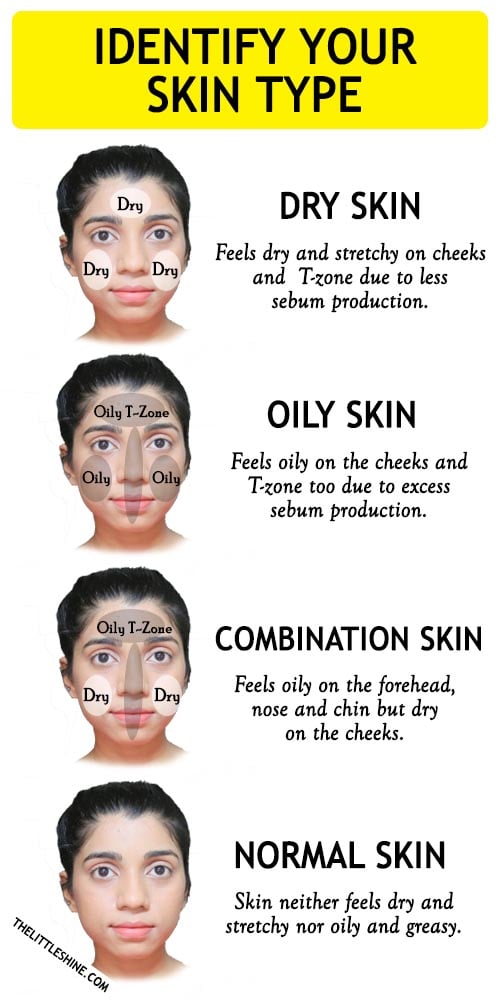Every individual has different skin type and the products that you use totally depends on what kind of skin do you have. Using random products without even considering your skin type can actually work the opposite and have long-lasting unpleasant consequences! Different skin type needs different and specific ingredients and products and if you are having a hard type determine your skin type, you are at the right place!

SKIN TYPES
DRY SKIN
Skin that lacks necessary amount of sebum and feels tighter is mostly dry skin. Dry skin in dry weathers can get chapped and flaky. Dry skin lacks the lipids needed to retain moisture in the skin which is why you need extra topical moisturizer. Skin that has scaly appearance and feels rough to touch is a sign that the skin is extremely dry and needs heavy moisturizers.
OILY SKIN
Oily skin produces more or excess sebum and can make your cheeks, nose and forehead look and feel shiny and greasy. Oily skin is more prone to pore clogging and needs extra care to keep whiteheads, comedones and blackheads in control. Oily skin can get really greasy in humid weathers and needs frequent blotting. One benefit of having this skin type is that skin doesn’t form early wrinkles and fine lines and looks younger for longer. Oily skin can be genetic or as a result of monaural changes. In most cases, oily skin also attracts acne.
COMBINATION SKIN
As the name suggests, combination skin is a mix of dry/normal and oily skin type. Your T-zone can feel shiny while your cheeks an feel dry. Multi-masking works the best for this skin type.
NORMAL SKIN
Normal skin is a type of skin that is well-balances in terms of sebum production and skin neither feels dry nor oily! This is the best kind of skin to have and needs minimal maintenance. Normal skin usually has fine pores, rare to no blemishes, smoother and texture-free skin. As normal skin age, it can become a little dry which is when you need to incorporate deep moisturizers in your skin care routine.
HOW TO IDENTIFY SKIN TYPE USING DIFFERENT METHODS
- One method is to properly cleanse your face using a gentle SLS-free cleanser (for this method to be effective) and pat dry. Let your skin stay bare for at least 1 hour and avoid touching it. Now, after 1 hour, if your T-zone looks shiny and cheeks feel and look normal or dry, then you have combination skin. If you entire face including forehead, nose, cheeks look and feel greasy and shiny then you have oily skin. If your face looks and feels dry, tight and stretchy then you have dry skin. If your skin doesn’t feel dry or oily but looks healthy and glowing, then you have normal skin.
- Second method is more appropriate and gives confirmed results. Cleanse and pat dry as mentioned in the previous method and after 1 hour, use a blotting sheet to check which areas soak more oil and which areas do not soak any oil at all. This way you can effectively determine your skin type.
